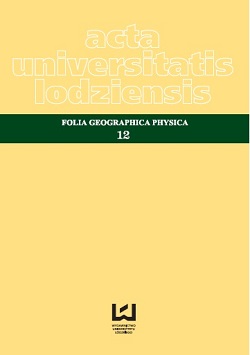Alaska jako przykład obszaru recepcji turystycznej
DOI:
https://doi.org/10.18778/1427-9711.12.04Słowa kluczowe:
Alaska, walory przyrodnicze, parki narodowe, turystykaAbstrakt
Stan Alaska położony jest na północnym-zachodzie Ameryki Północnej. Zajmuje on 1 717 854 km2 powierzchni, którą zamieszkuje 731 449 mieszkańców (2012 r.). Gęstość zaludnienia jest niewielka i wynosi zaledwie 0,5 os/km2. Wpływ na tę sytuację mają przede wszystkim stosunkowo niekorzystne warunki naturalne, z których najważniejszy wpływ mają warunki klimatyczne, wieloletnia zmarzlina i ukształtowanie terenu. Różnorodność krajobrazu będąca efektem ogromnego zróżnicowania form rzeźby, zdecydowała, iż na terenie Alaski utworzono 8 parków narodowych (Denali National Park, Gates of the Arctic National Park, Glacier Bay National Park, Katmai National Park, Kenai Fjords National Park, Kobuk Valley National Park, Lake Clark National Park, Wrangell‒St. Elias National Park), utworzono pomniki narodowe oraz obszary o niższej randze ochrony. Każdy z tych obszarów stanowi magnes przyciągający rzesze turystów z USA i z całego świata, gdyż znajdują się tu niepowtarzalne formy krajobrazu, jak lodowce, aktywne wulkany, fiordy, wysokie góry. Obszary te mają ogromne znaczenie dla rozwoju turystyki w USA, a tym samym dla gospodarki. Rocznie tylko Alaskę odwiedza ok. 2 mln osób.
Pobrania
Bibliografia
Alaska Visitor Statistic Program VI, Interim Visitor Volume Report, Summer 2012, McDowell Group, Inc., s. 1‒10.
Google Scholar
Alaska Visitor Statistic Program VI, Interim Visitor Volume Report, Fall/Winter 2012‒2013, McDowell Group, Inc., s. 1‒7
Google Scholar
Bielak S.R., 2012, Parki narodowe i rezerwaty Alaski. Od Aleutów aż po bezdroża Arktyki, Podkarpacki Instytut Książki i Marketingu, Kraków, s. 146‒157, 213‒227.
Google Scholar
Catton T., 2010, A Fragile Beauty: An Administrative History of Kenai Fjords National Park, National Park Service http://www.nps.gov/kefj/historyculture/upload/A-Fragi-le-Beauty-AdminHistory-of-KEFJ.pdf dostęp 06.12.2013.
Google Scholar
Denali: The story behind the scenery, 1997, Wyd. 15 — 2012, KC PUBLICATIONS, INC.
Google Scholar
Dziedzic E., 1998, Obszar recepcji turystycznej jako przedmiot zarządzania strategicznego, Monografie i Opracowania, SGH, Warszawa, s. 9.
Google Scholar
Forest Facts, US Forest Service http://www.fs.usda.gov/detail/chugach/about-forest/?cid=STELPRDB5053239
Google Scholar
Gaworecki W., 2003, Turystyka, PWE, Warszawa, ss. 125.
Google Scholar
Jelonek A., Soja M. (red.), 1996, Ameryka Północna. Encyklopedia Geograficzna Świata, OPRESS, Kraków, ss. 37.
Google Scholar
Kaczmarek J., Stasiak J., Włodarczyk B., 2005, Produkt turystyczny, PWE, Warszawa, s. 51‒57.
Google Scholar
Kelley M., Simpson S., 2010, Glacier Bay National Park, Alaska, s. 114‒119.
Google Scholar
Kowalczyk A., 2001, Geografia turyzmu, Wydawnictwo Naukowe PWA, Warszawa, ss. 97.
Google Scholar
Kożuchowski K., 2005, Walory przyrodnicze w turystyce i rekreacji, Wydawnictwo Kurpisz S.A., Poznań, s. 11‒13.
Google Scholar
Land Areas of the National Forest System, 2011, United States Department of Agriculture http://www.fs.fed.us/land/staff/lar/LAR2011/LAR2011_Book_A5.pdf dostęp 06.12.2913.
Google Scholar
Lijewski T., Mikułowski B., Wyrzykowski J., 2002, Geografia turystyczna Polski, PWE, Warszawa, ss. 16.
Google Scholar
Okołowicz W., 1969, Klimatologia ogólna, PWN, Warszawa, ss. 393.
Google Scholar
Rozen N., 1998, Harding Icefield's Loss is the Ocean's Gain, Alaska Science Forum, Article 1385 http://www.gi.alaska.edu/ScienceForum/ASF13/1385.html dostęp 06.12.2013.
Google Scholar
Pobrania
Opublikowane
Jak cytować
Numer
Dział
Licencja

Utwór dostępny jest na licencji Creative Commons Uznanie autorstwa – Użycie niekomercyjne – Bez utworów zależnych 4.0 Międzynarodowe.










